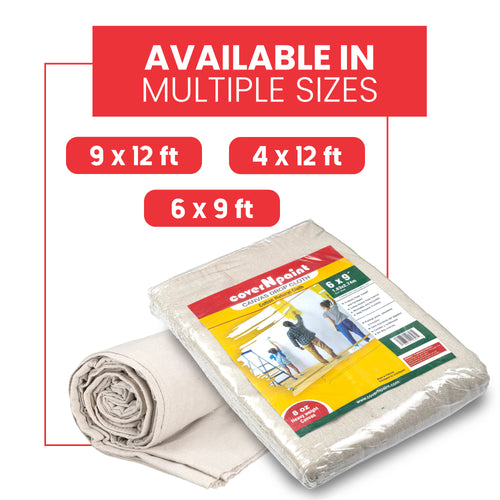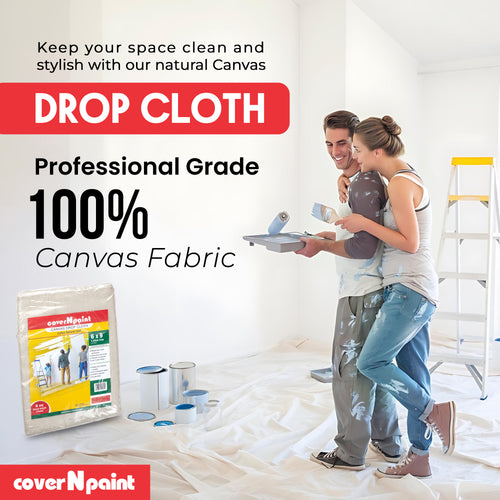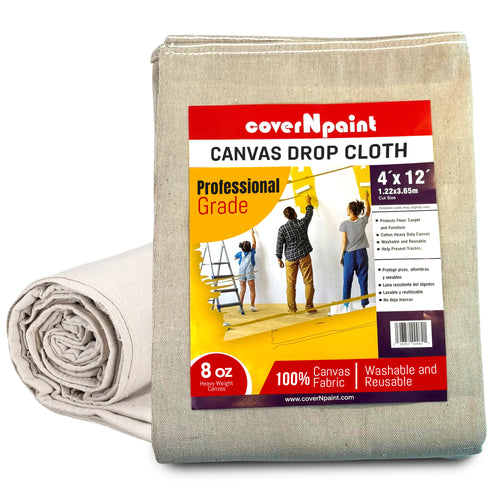When painting an apartment, it's crucial to protect surfaces from paint splatters and spills. For both professional painters and DIY enthusiasts, choosing the right protective coverings can greatly simplify the cleanup process. Painters tarps are a commonly used option for such painting projects.
Understanding Tarps as Protective Coverings
Tarps, short for tarpaulins, are large sheets made from materials like canvas, plastic, or vinyl. They are designed to protect surfaces from dirt, moisture, and, of course, paint. Available in various sizes, weights, and materials, tarps are commonly used in outdoor projects, construction, and even camping. In painting, they are valued for their ability to cover large areas, but how do they fare in the specific environment of apartment painting?

Types of Tarps Available
There are several types of tarps that painters might consider:
Canvas Tarps:
Made from heavy-duty, durable fabric, these tarps are often favored by professionals. They offer excellent absorbency, preventing paint from seeping through and damaging floors or furniture.
Plastic Tarps:
Lightweight and often inexpensive, plastic tarps are easy to spread out and dispose of after use. However, they lack absorbency and can be slippery.
Vinyl Tarps:
Known for their strength and resistance to tearing, vinyl tarps can withstand heavy use. They are often used in more demanding projects but can be overkill for smaller apartment jobs.
Advantages of Using Tarps in Apartment Painting
Tarps have several key advantages when used for apartment painting:
Wide Coverage:
One of the biggest advantages of tarps is their ability to cover large areas. Whether you're covering furniture, flooring, or even entire rooms, tarps can be spread out to protect everything from unwanted paint splashes.
Durability:
Depending on the material, tarps can be extremely durable. Canvas, for example, is known for its strength and ability to withstand multiple uses. This can be particularly useful for larger apartment projects that may take several days or even weeks to complete.
Reusable:
High-quality tarps, such as those made from canvas, can be reused for multiple projects. This can be a cost-effective solution for both professionals and DIY painters who frequently engage in painting activities.
Waterproof Options:
Some tarps are designed to be waterproof, which can be beneficial if you're dealing with wet paint or working in a damp environment. This feature ensures that moisture doesn't seep through the tarp and damage the surfaces underneath.
Customizable Size:
Tarps come in various sizes and can be cut to fit specific areas. This flexibility allows painters to customize the coverage to meet the unique needs of their apartment painting project.
Choosing the Right Protective Covering for Apartment Painting
The choice of protective covering depends on several factors, including the size of the apartment, the type of surfaces being protected, and the specific requirements of the painting project. Here are some considerations to help you choose the right option:
Size of the Area:
If you're painting a large area or multiple rooms, tarps may be a more efficient option due to their size. However, for smaller spaces, drop cloths or paper rolls may be easier to manage.
Type of Flooring:
Consider the type of flooring in your apartment. If you have hardwood floors, canvas or paper may be better choices due to their absorbency. For carpeted floors, carpet protection film might be more appropriate.
Frequency of Use:
If you frequently paint or take on multiple projects, reusable canvas tarps or drop cloths are a wise investment for long-term savings and sustainability. They withstand repeated use and offer better coverage, making them cost-effective over time. However, for single-use projects or occasional painting, plastic tarps or sheeting can be a practical and economical choice.
Environmental Impact:
For eco-conscious painters, reusable options like canvas or paper rolls are preferable to disposable plastic sheeting. Canvas tarps can be used again and again, reducing waste and minimizing the environmental impact of your painting project.
Best Practices for Using Tarps in Apartment Painting
If you decide to use tarps for your apartment painting project, here are some best practices to ensure success:
Secure the Tarp:
To prevent slipping and shifting, secure your tarp using painter's tape or weights. This will ensure the tarp stays in place, providing complete coverage and minimizing the risk of accidents. Properly securing the tarp not only keeps your work area clean but also enhances safety by reducing potential tripping hazards.
Choose the Right Material:
When selecting a tarp for your project, it's crucial to match the material to your specific needs. If absorbency is a priority, canvas tarps are ideal due to their high absorbent properties. However, for situations requiring waterproofing, vinyl tarps are a better choice, offering excellent resistance to water. Assessing these factors will ensure you choose the most effective tarp for your project’s demands.
Avoid Overlapping:
When using multiple tarps, it’s important to minimize excessive overlapping to prevent gaps and uneven surfaces. Lay each tarp flat and smooth, avoiding bunches or wrinkles. Secure the seams with tape to create a seamless barrier, ensuring complete and reliable coverage. This approach helps maintain a uniform surface and prevents any potential leaks or exposure.
Protect Furniture:
In addition to protecting your floors, it's essential to shield your furniture during a painting project. Use smaller tarps or drop cloths to cover items like couches, tables, and chairs that can't be relocated. This extra precaution prevents paint splatters and stains from ruining your beloved furniture, ensuring your space remains clean and untouched throughout the process.
Clean Up Immediately:
Once your painting project is complete, remove the tarps carefully to avoid spreading any paint that may have dripped onto them. Fold the tarps inward to trap any paint and dispose of or clean them according to the material.
Ending point
The answer to whether tarps are the right choice for apartment painting ultimately depends on the specific needs of your project. Tarps offer wide coverage, durability, and reusability, making them a strong option for larger painting jobs. However, they also come with drawbacks such as weight, slipperiness, and limited absorbency in some cases.













